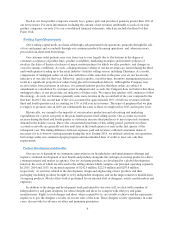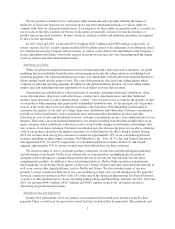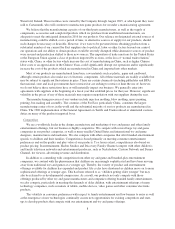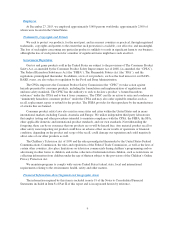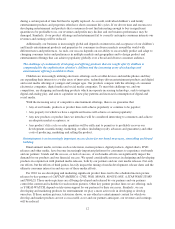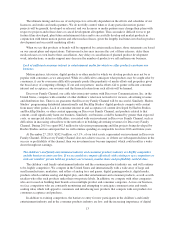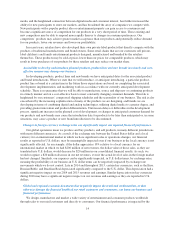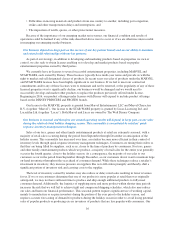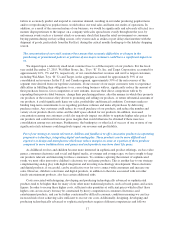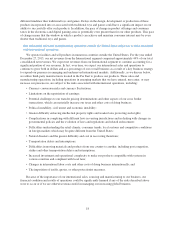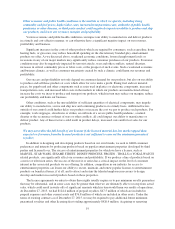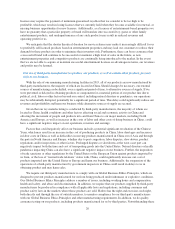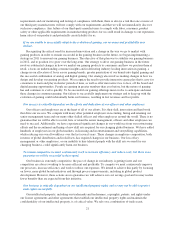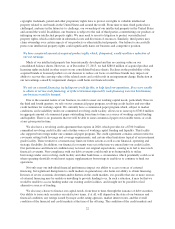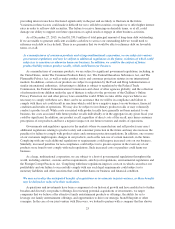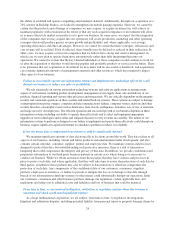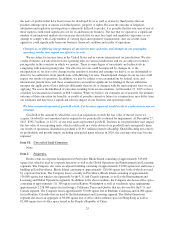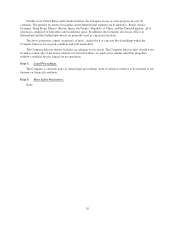Hasbro 2015 Annual Report Download - page 27
Download and view the complete annual report
Please find page 27 of the 2015 Hasbro annual report below. You can navigate through the pages in the report by either clicking on the pages listed below, or by using the keyword search tool below to find specific information within the annual report.• Difficulties in moving materials and products from one country to another, including port congestion,
strikes and other transportation delays and interruptions; and
• The imposition of tariffs, quotas, or other protectionist measures.
Because of the importance of our emerging market net revenues, our financial condition and results of
operations could be harmed if any of the risks described above were to occur or if we are otherwise unsuccessful
in managing our emerging market business.
Our business depends in large part on the success of our key partner brands and on our ability to maintain
and extend solid relationships with our key partners.
As part of our strategy, in addition to developing and marketing products based on properties we own or
control, we also seek to obtain licenses enabling us to develop and market products based on popular
entertainment properties owned by third parties.
We currently have in-licenses to several successful entertainment properties, including MARVEL and
STAR WARS, each owned by Disney. These licenses typically have multi-year terms and provide us with the
right to market and sell designated classes of products. In recent years our sales of products under the MARVEL
and STAR WARS licenses have been highly significant to our business. If we fail to meet our contractual
commitments and/or any of these licenses were to terminate and not be renewed, or the popularity of any of these
licensed properties was to significantly decline, our business would be damaged and we would need to
successfully develop and market other products to replace the products previously offered under license.
Beginning in 2016, our product offerings under licenses with Disney will expand to include product offerings
based on the DISNEY PRINCESS and FROZEN brands.
Our license to the MARVEL property is granted from Marvel Entertainment, LLC and Marvel Characters
B.V. (together “Marvel”). Our license to the STAR WARS property is granted by Lucas Licensing Ltd. and
Lucasfilm Ltd. (together “Lucas”). Both Marvel and Lucas are owned by The Walt Disney Company.
Our business is seasonal and therefore our annual operating results will depend, in large part, on our sales
during the relatively brief holiday shopping season. This seasonality is exacerbated by retailers’ quick
response inventory management techniques.
Sales of our toys, games and other family entertainment products at retail are extremely seasonal, with a
majority of retail sales occurring during the period from September through December in anticipation of the
holiday season. This seasonality has increased over time, as retailers become more efficient in their control of
inventory levels through quick response inventory management techniques. Customers are timing their orders so
that they are being filled by suppliers, such as us, closer to the time of purchase by consumers. For toys, games
and other family entertainment products which we produce, a majority of retail sales for the entire year generally
occur in the fourth quarter, close to the holiday season. As a consequence, the majority of our sales to our
customers occur in the period from September through December, as our customers do not want to maintain large
on-hand inventories throughout the year ahead of consumer demand. While these techniques reduce a retailer’s
investment in inventory, they increase pressure on suppliers like us to fill orders promptly and thereby shift a
significant portion of inventory risk and carrying costs to the supplier.
The level of inventory carried by retailers may also reduce or delay retail sales resulting in lower revenues
for us. If we or our customers determine that one of our products is more popular at retail than was originally
anticipated, we may not have sufficient time to produce and ship enough additional products to fully meet
consumer demand. Additionally, the logistics of supplying more and more product within shorter time periods
increases the risk that we will fail to achieve tight and compressed shipping schedules, which also may reduce
our sales and harm our financial performance. This seasonal pattern requires significant use of working capital,
mainly to manufacture or acquire inventory during the portion of the year prior to the holiday season, and
requires accurate forecasting of demand for products during the holiday season in order to avoid losing potential
sales of popular products or producing excess inventory of products that are less popular with consumers. Our
16


